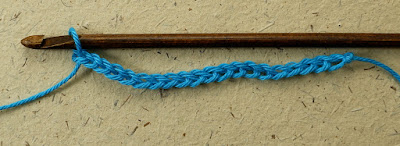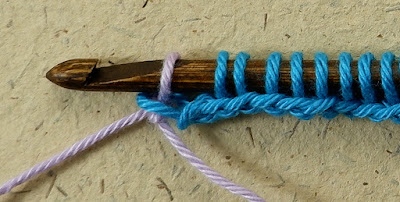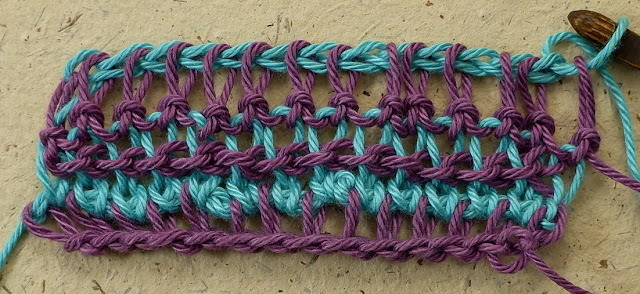I started writing these Long Hook crochet posts because I was so confused by all the different techniques. Some bloggers will lead you to believe they are all the same technique. I decided that there was only one way to find out.
CrochenitTM is a reversible Tunisian crochet method which was invented by Mary Middleton in the 1970's. It came to international attention at the beginning of this century. The three things that distinguish Crochenit from other types of crochet are: that it uses a double-ended hook, is reversible, and uses two balls of yarn. This makes it perfect for colour-work.
Let's start by showing you how it works. I am going to demonstrate Tunisian Simple stitch worked in Crochenit.
Start exactly as you would for Tunisian Simple Stitch by making as many chain as stitches required.
Turn the hook, sliding all the stitches to the opposite end. With the second colour make a slip knot and place the loop on the hook.
Yarn over and pull through the next two loops, repeat to the end of the row. [In Tunisian crochet this would be referred to as the Return Pass but in Crochenit it is classed as a separate row.]
Working forward again, the loop on the hook counts as the first stitch. Place the hook under the next vertical bar from right to left, yarn over the hook and pull a loop through.
Pull up a loop under each bar to the end.
Each colour is used to work two rows before the hook is turned. It seems complicated but in practice it's easy to remember when to turn the hook. Additionally, if you turn the hook alternately clockwise and anti clockwise there is no need to keep swapping the yarn balls from side to side.
Pick up the other colour, yarn over and pull through the first loop only,
Yarn over and pull through two loops, repeat to the end of the row working the stitches off the hook.
At the end you can either fasten off after working a 'row3' or slip stitch across using the vertical bars after a 'row3'. I showed you how to do this in a previous post on Tunisian crochet.
We can compare the Tunisian Simple Stitch sample and this one made with Crochenit. Besides being reversible the Crochenit is also lighter in weight and slightly ribbed.
Unfortunately patterns and pattern books are hard to find in the UK. The booklet that I have includes three patterns. They introduced me to a stitch called a High stitch which is made like this.
After pulling up a loop under the horizontal chains...
...Yarn over and pull through the loop on hook to create a chain1.
Alternately you can pull up a loop under the vertical bar, then yarn over and pull through the loop on hook to create a chain1.
I made this swatch exactly like Simple Stitch but replaced the normal Row2 with a row of High stitches.
I made this swatch by alternating High stitch and Simple Stitch on Row2. And alternating Simple stitch and High stitch on Row4.
I tried experimenting with other Tunisian stitches with mixed success. But this was my favourite, it is a slight variant on an existing Tunisian stitch that I'd found.
Foundation row:
Chain a multiple of 2 stitches plus an additional 2 stitches.
Pull up a loop in 2nd chain from the hook and in each stitch to the end, Chain1 and turn.
Row1.
Attach new colour to the hook with a slip knot, pull through the first stitch.
(Yarn over and pull through 3 loops on the hook.) repeat to the last two stitches. Yarn over and pull through last two loops on hook.
Row2.
Chain1, (Place hook into chain space, yarn over and pull through a loop, Chain1, place hook under next 2 vertical bars together, yarn over and pull through a loop) repeat to last chain space, skip last space, pull up a loop in last vertical bar, Chain1, Turn.
Pick up the other colour, pull up a loop in first stitch, (Yarn over and pull through 3 loops on hook,) repeat to last 2 stitches on hook, yarn over and pull through last two loops on hook.
I am now convinced that if you enjoy Tunisian crochet and would like a new challenge then you should be able to work out some original patterns of your own. I can attest to how satisfying it is!
Fastening off...





























how do you keep it from curling up
ReplyDeleteI didn't have any problem with curling edges using this technique! However try this video by TL Yarn crafts who is the real Tunisian crochet expert! https://www.youtube.com/watch?v=pk0he_p_HIY
Delete